Computer Hardware Peripherals¶
Introduction¶
A peripheral is a piece of computer hardware that is added to a computer in order to expand its abilities. The term peripheral is used to describe those devices that are optional in nature, as opposed to hardware that is either demanded or always required in principle. There are all different kinds of peripherals you can add your computer. The main disctinction among peripherals is the way they are connected to your computer. They can be connected internally or externally.
Buses¶
A bus is a subsystem that transfers data between computer components inside a computer or between computers. Unlike a point-to-point connection, a bus can logically connect several peripherals over the same set of wires. Each bus defines its set of connectors to physically plug devices, cards or cables together. There are two types of buses: internal and external. Internal buses are connections to various internal components. External buses are connections to various external components. There are different kinds of slots that internal and external devices can connect to.
Internal¶
Types of Slots¶
There are many different kinds of internal buses, but only a handful of popular ones. Different computers come with different kinds and number of slots. It is important to know what kind and number of slots you have on your computer before you go out and by a card that matches up to a slot you don’t have.
PCI¶
PCI (Peripheral Component Interconnect) is common in modern PCs. This kind of bus is being succeeded by PCI Express. Typical PCI cards used in PCs include: network cards, sound cards, modems, extra ports such as USB or serial, TV tuner cards and disk controllers. Video cards have outgrown the capabilities of PCI because of their higher bandwidth requirements.

PCI Slots
PCI Express¶
PCI Express was introduced by Intel in 2004. It was designed to replace the general-purpose PCI expansion bus and the AGP graphics card interface. PCI express is not a bus but instead a point-to-point conection of serial links called lanes. PCI Express cards have faster bandwidth then PCI cards which make them more ideal for high-end video cards.
PCMCIA¶
PCMCIA (also referred to as PC Card) is the type of bus used for laptop computers. The name PCMCIA comes from the group who developed the standard: Personal Computer Memory Card International Association. PCMCIA was originally designed for computer memory expansion, but the existence of a usable general standard for notbeook peripherals led to many kinds of devices being made available in this form. Typical devices include network cards, modems, and hard disks.
AGP¶
AGP (Accelerated Graphics Port) is a high-speed point-to-point channel for attaching a graphics card to a computer’s motherboard, primarily to assist in the acceleration of 3D computer graphics. AGP has been replaced over the past couple years by PCI Express. AGP cards and motherboards are still available to buy, but they are becoming less common.

AGP Slot
Types Of Cards¶
Video Card¶
A video card (also known as graphics card) is an expansion card whose function is to generate and output images to a display. Some video cards offer added functions, such as video capture, TV tuner adapter, ability to connect multiple monitors, and others. Most video cards all share similar components. They include a graphics processing unit (GPU) which is a dedicated microprocessor optimized for 3D graphics rendering. It also includes a video BIOS that contains the basic program that governs the video card’s operations and provides the instructions that allow the computer and software to interface with the card. If the video card is integrated in the motherboard, it may use the computer RAM memory. If it is not it will have its own video memory called Video RAM. This kind of memory can range from 128MB to 2GB. A video card also has a RAMDAC (Random Access Memory Digital-to-Analog Converter) which takes responsibility for turning the digital signals produced by the computer processor into an analog signal which can be understood by the computer display. Lastly, they all have outputs such as an HD-15 connector (standard monitor cable), DVI connector, S-Video, composite video or component video.
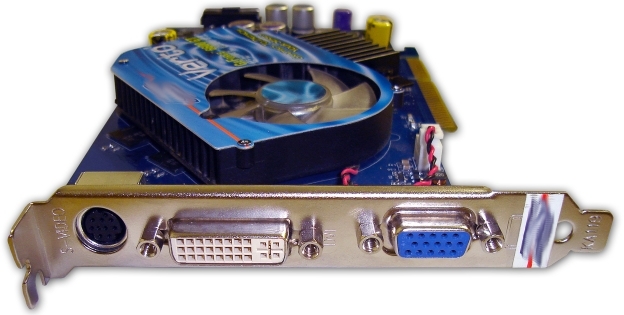
Graphics Card
Sound Card¶
A sound card is an expansion card that facilitates the input and output of audio signals to/from a computer under control of computer programs. Typical uses for sound cards include providing the audio component for multimedia applications such as music composition, editing video or audio, presentation/education, and entertainment. Many computers have sound capabilities built in,, while others require additional expansion cards to provide for audio capability.
Network Card¶
A network card is an expansion card that allows computers to communicate over a computer network. It allows users to connect to each other either by using cables or wirelessly. Although other network technologies exist, Ethernet has achieved near-ubiquity for a while now. Every Ethernet network card has a unique 48-bit serial number called a MAC address, which is stored in ROM carried on the card. You can learn more about networking in the introduction to networking lesson.
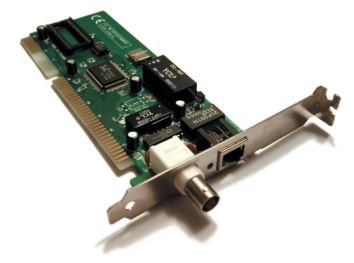
Network Card
External¶
Types of Connections¶
USB¶
USB (Universal Serial Bus) is a serial bus standard to interface devices. USB was designed to allow many peripherals to be connected using a single standardized interface socket and to improve the plug-and-play capabilities by allowing devices to be connected and disconnected without rebooting the computer. Other convient features include providing power to low-consumption devices without the need for an external power supply and allowing many devices to be used without requiring manufacturer specific, individual device drivers to be installed. USB is by far the dominating bus for connecting external devices to your computer.
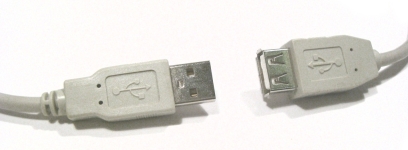
USB Connectors
Firewire¶
Firewire (technically known as IEEE 1394 and also known as i.LINK for Sony) is a serial bus interface standard for high-speed communications and isochronous real-time data transfer, frequently used in a personal computer. Firewire has replaced Parallel ports in many applications. It has been adopted as the High Definition Audio-Video Network Alliance (HANA) standard connection interface for A/V (audio/visual) component communication and control. Almost all modern digital camcorders have included this connection.
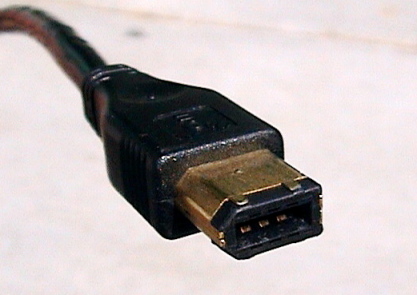
Firewire Cable
PS/2¶
The PS/2 connector is used for connecting some keyboards and mice to a PC compatible computer system. The keyboard and mouse interfaces are electrically similar with the main difference being that open collector outputs are required on both ends of the keyboard interface to allow bidirectional communication. If a PS/2 mouse is connected to a PS/2 keyboard port, the mouse may not be recognized by the computer depending on configuration.
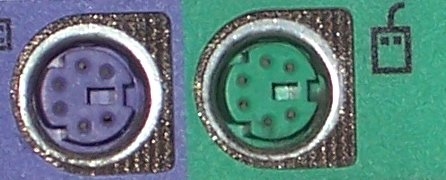
PS/2 Ports
Devices¶
Removable Storage¶
The same kinds of CD and DVD drives that could come built-in on your computer can also be attached externally. You might only have a CD-ROM drive built-in to your computer but you need a CD writer to burn CDs. You can buy an external CD writer that connects to your USB port and acts the same way as if it was built-in to your computer. The same is true for DVD writers, Blu-ray drives, and floppy drives. Flash drives have become very popular forms of removable storage especially as the price of flash drives decreases and the possible size for them increases. Flash drives are usually USB ones either in the form USB sticks or very small, portable devices. USB flash drives are small, fast, removable, rewritable, and long-lasting. Storage capacities range from 64MB to 32GB or more. A flash drive does not have any mechanically driven parts so as opposed to a hard drive which makes it more durable and smaller usually.
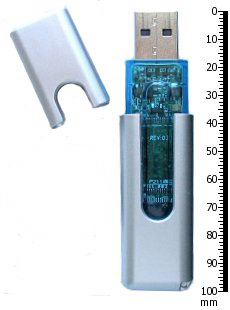
USB Flash Drive
Non-removable Storage¶
Non-removable storage can be a hard drive that is connected externally. External hard drives have become very popular for backups, shared drives among many computers, and simply expaning the amount of hard drive space you have from your internal hard drive. External hard drives come in many shapes and sizes like flash drives do. An external hard drive is usually connected by USB but you can also have a networked hardrive which will connect to your network which allows all computers on that network to access that hard drive.
Input¶
Input devices are absolutely crucial to computers. The most common input devices are mice and keyboards which barely every computer has. A new popular pointing device that may eventually replace the mouse is touch screen which you can get on some tablet notebooks. Other popular input devices include microphones, webcams, and fingerprint readers which can also be built in to modern laptops and desktops. A scanner is another popular input device that might be built-in to your printer.

Webcam
Output¶
There are lots of different kinds of output devices that you can get for your computer. The absolute most common external output device is a monitor. Other very popular output devices are printers and speakers. There are lots of different kinds of printers and different sizes of speakers for your computer. Monitors are connected usually through the HD-15 connector on your video card. Printers are usually connected through a USB port. Speakers have their own audio out port built-in to the sound card.

Monitor
References¶
- Wikipedia - Expansion card
- Wikipedia - Computer hardware
- Wikipedia - Computer peripheral
- Wikipedia - Computer bus
- Wikipedia - Peripheral Component Interconnect
- Wikipedia - PCI Express
- Wikipedia - Accelerated Graphics Port
- Wikipedia - Video card
- Wikipedia - Sound card
- Wikipedia - Network card
- Wikipedia - USB
- Wikipedia - Firewire
- Wikipedia - PS/2 Connector
- Wikipedia - USB flash drive
- Wikipedia - Webcam